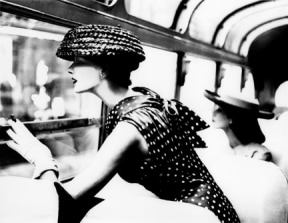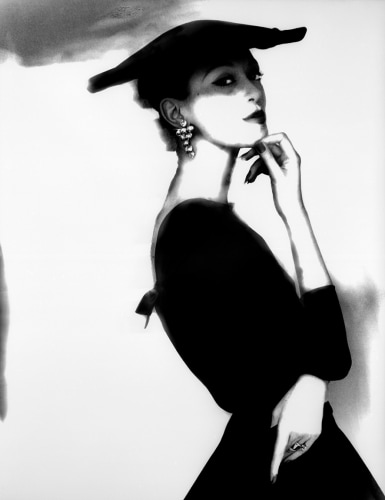

Ever since John Galliano arrived at Dior in 1996, he has been looking for ways to transcend the earthbound limits of fashion. He has made clothes that look as if they are falling apart or stuck on with sweat, and he has staged his shows in some fairly lofty places like Versailles and the Paris Opera. But not until this past summer, when Mr. Galliano transferred the techniques of fashion illustration to dressmaking, using black beads on nude chiffon to impart the brisk lines of the artist, did you feel that he had finally conquered the problem of gravity.
Among the influences he cited were the experimental fashion photographs of Lillian Bassman, whose work originally appeared in Harper's Bazaar in the 1940's and 50's, was nearly all destroyed in the 70's, and found a new audience in the 90's from what remained.
In an e-mail message from France this week, Mr. Galliano said he admired Ms. Bassman's "painterly strokes of light," an effect she achieved in the darkroom with bleaching and blurring - and which in later years, when she felt no commercial pressures, took ever further. "It was this technique and spirit that I wanted to capture in the dressmaking process," he said.
It is not rare for a designer to see connections to the past that rightly exist, but it is extremely rare for the rest of us to be able to see the genius of one individual so vividly translated in the work of another.
Ms. Bassman is having a revival, with gallery shows opening this month in California and New York. Actually she has been undergoing a revival in the decade since a British curator named Martin Harrison, on one of his regular visits to her home in New York, opened a garbage bag in her darkroom and discovered the remains of a lifetime of work.
Mr. Harrison, believing that nothing had survived a housecleaning in 1971, when Ms. Bassman threw out bags of negatives, remembers the exhilaration of seeing envelopes marked "Harper's Bazaar 1948," and telling her, "Lillian, here's your project." He laughed, saying, "She was not at all interested."
By 1994, however, she was back to the darkroom and making new prints from the surviving negatives (about 50 in all), which the Bulfinch Press published in a slim monograph. She also had several one-woman shows, and in 1996, was hired by Neiman Marcus to shoot an advertising campaign, the same year that Franciscus Ankone, then a stylist for The New York Times Magazine, asked her to photograph the couture collections in Paris.
"I didn't even know she was still alive," Mr. Ankone said from Amsterdam. "She started to laugh and said, 'I haven't worked commercially for so long.' I said, 'Look, we're going to work together eventually.' Then she said, 'How much do you pay?' I said, 'It's not for the money.' And she said, 'O.K., I'll do it.' She arrived in Paris with one little suitcase and a camera."
She was then 80 years old.
"She is as important to fashion photography as Richard Avedon and Irving Penn," said Peter Fetterman, whose Santa Monica gallery will have a show, starting Nov. 19. (Staley-Wise in SoHo will have a smaller exhibit, opening tomorrow.) "She just didn't get the recognition they got," Mr. Fetterman said.
While Ms. Bassman might have been only too game in her day to take on the boys, and certainly you don't find the same heartbreaking intimacy in the pictures of that other Bazaar war horse, Louise Dahl-Wolfe, her work is limited in its romantic scope and limited by what remained in the bag that refused to leave the house. But the question of recognition may be too contemporary a rant to throw at a life that was as ardent and politically charged as it was insistently original. The complaint just bounces off.
When I telephoned Ms. Bassman last week to ask if I might come by to see her, she replied sweetly if vaguely: "Oh, sure. Why not?"
Perhaps the most important thing about her is that when she began living with her husband, Paul Himmel, she was 15 and Herbert Hoover was president. Indeed, it's impossible to talk about Lillian Bassman without talking about Paul Himmel, who is 91. The children of Russian Jews, they first met in the summer of 1923 at Coney Island, where Ms. Bassman's mother worked as a waitress at a vegetarian boarding house owned by Mr. Himmel's parents.
"Paul and I were at the Frick the other day," Ms. Bassman said, "and I realized, looking at the Memlings, that's where my fashion education started. As teenagers, we didn't have any money. Our whole thing was going to galleries."
They were part of the leftist art scene that flourished in New York during the Depression. In a 1995 profile in The New Yorker of Roz Roose, a colorful Trotskyite who was also known for her parties, Ms. Bassman recalled how the two women - tremendous lookers in their day - organized strikes to protest financing cuts at the WPA Artists Project, where they worked for $21.56 a week as painters. On one occasion, they stripped and picketed nude in front of the Art Students League. In the profile, Ms. Roose summed up what she loved about her husband, Larry, a psychoanalyst: "He wasn't dazzling but he was progressive." Belief mattered.
As Mr. Harrison said, "To use an old-fashioned term, Lillian and Paul are so devoted to not being square."
Mr. Himmel buzzed me in the front door and waved me up the stairs. Though slowed by a broken hip suffered last year, he seemed fit. He was wearing khakis, a sports shirt and a pair of shoes that had been painted green. In 1956 he and Ms. Bassman bought a carriage house on the Upper East Side for $75,000. By then, they were both successful commercial photographers, with Mr. Himmel producing for himself pictures of astonishing grit and beauty - crowds moving through Grand Central Terminal - and they used the carriage level for their studio, occupying the upper two floors with their young children, Eric and Lizzie. (In 1971, disenchanted with his commercial work, Mr. Himmel went back to school and became a psychotherapist. His wife says he never picked up a camera again.)
The living room looks like a large bohemian loft: the tables are crowded with collections of bottles (a lot of them green), old clocks, mechanical parts, and Cornell-like collages that Mr. Himmel has made over the years. The dried brown foliage of climbing vines clings to walls. While I was waiting for Ms. Bassman, I noticed some large Cibachrome prints of flowers - she made them in the 80's - scattered on a table. I turned around. On a stack of papers was a contact sheet of Dick Avedon as a young man. In the late 40's, the Himmels used to share a cottage on Fire Island with Mr. Avedon and his first wife, Doe.
"We had a car that cost - what? - a 100 bucks, maybe 200 bucks," said Ms. Bassman, who had on a fleece top and black slacks and was barefoot. "When all our friends were buying Jaguars, Paul and I were driving a 1950 Studebaker. We traveled, but we didn't spend money. I never spent more than $100 on a dress. We lived well. We always managed to spend money on what we wanted but never the luxuries."
But as their children affectionately point out, there were moments of illogic in their parents' old lefty values. "Like a lot of their friends, they went through a period of aspiring to be in the upper middle class," said Eric Himmel, who is the editor in chief of Abrams Books. "They sent us to private school, and then they would scorn you because you didn't go to public school." He laughed. And he adds that while his parents may have bought their carriage house for a song by today's standards, $75,000 was a lot of money in 1956.
In the Roz Roose profile, Arthur Penn said of the art scene in the 30's: "There was a double standard. The girls were artists but ornamental - intelligent, talented, yet girls first." Lizzie Himmel suggests that for photographers like her mother, with families, there were gender and cultural divides they were not prepared to challenge.
Asked why she thought her mother did not achieve the reputation of an Avedon, Ms. Himmel said, "My mother went to PTA meetings. Dick's life revolved around the studio. But she's no wilting lily. Her marriage was really important to her."
I said to Eric Himmel, whose own family lives in the lower level of the carriage house, where the studio used to be, that it must have been unique to grow up in New York with parents who had not only spent a lifetime together but also weren't overly absorbed in money and status. He agreed that it was.
But he said: "When I was growing up, I had a lot of resistance to their influence. They were judgmental of visual taste, of one's friends. Sometimes it seemed they drew strength from not embracing the conventional world. But now I think they're just amazing."
Did Mr. Himmel the publisher ever think of doing a book about his parents? He laughed. "I have thought about it a lot, actually," he said. "When my father broke his hip, my son went upstairs and took hundreds of photographs. It was a young person's amazing take on this eccentric place. I even have a name for the book: 'The New Masses Ball.'
He explained. "We were out on Fire Island - this was maybe 15 or 20 years ago - and Roz Roose was there. We were playing a song by Frank Sinatra. We never played that much music at Fire Island. My parents started dancing, and we were, like, they're incredible. And Roz said, 'This is nothing. You should have seen them at the New Masses Ball.'